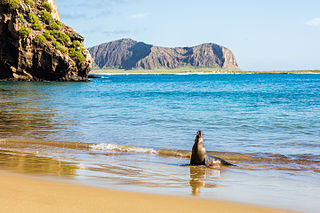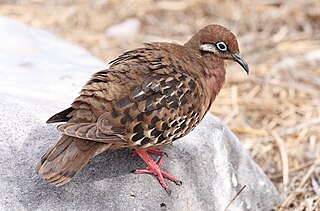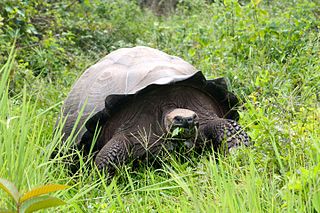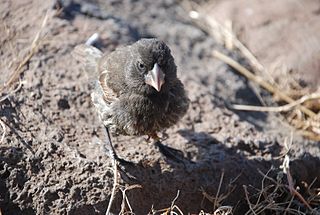
The Galápagos Islands, part of the Republic of Ecuador, are an archipelago of volcanic islands distributed on either side of the equator in the Pacific Ocean surrounding the centre of the Western Hemisphere. Located 906 km (563 mi) west of continental Ecuador, the islands are known for their large number of endemic species that were studied by Charles Darwin during the second voyage of HMS Beagle. His observations and collections contributed to the inception of Darwin's theory of evolution by means of natural selection.

Giant tortoises are any of several species of various large land tortoises, which include a number of extinct species as well as a few living species formerly common on the islands of the western Indian Ocean and on the Galápagos Islands.

The Pinta Island tortoise, also known as the Pinta giant tortoise, Abingdon Island tortoise, or Abingdon Island giant tortoise, is a species of Galápagos tortoise native to Ecuador's Pinta Island that is most likely extinct.

Española Island is part of the Galápagos Islands. The English named it Hood Island after Viscount Samuel Hood. It is located in the extreme southeast of the archipelago and is considered, along with Santa Fe, one of the oldest, at approximately four million years. A popular tourist stop, Isla Española is the most southerly island in the Galápagos Archipelago. The climate is very dry, like most of the Archipelago. But due to the flatness of the island, it is the driest of these islands, with only a few inches of rain per year. It is about a 10- to 12-hour trip by boat from Isla Santa Cruz.

San Cristóbal Canton is a canton of Ecuador in the Galápagos Islands archipelago and one of the oldest in this insular geological formation. It consists of Española, Floreana, Genovesa, San Cristóbal, and Santa Fe Islands.

The Galápagos tortoise complex or Galápagos giant tortoise complex is a species complex of 15 very large tortoise species in the genus Chelonoidis. They are the largest living species of tortoise, with some modern Galápagos tortoises weighing up to 417 kg (919 lb). With lifespans in the wild of over 100 years, they are one of the longest-lived vertebrates. A captive individual, Harriet, lived for at least 175 years. Spanish explorers, who discovered the islands in the 16th century, named them after the Spanish galápago, meaning "tortoise".

The Galápagos dove is a species of bird in the family Columbidae. It is endemic to the Galápagos, off Ecuador. It is fairly common and is found in a wide range of open and semi-open habitats, especially in the arid lowlands of the archipelago.

The common cactus finch or small cactus finch is a species of bird in the Darwin's finch group of the tanager family Thraupidae. It is endemic to the Galapagos Islands, where it is found on most islands, with the notable exception of Fernandina, Española, Genovesa, Darwin and Wolf. Most of these islands are inhabited by its close relative, the Española cactus finch.

Lonesome George was a male Pinta Island tortoise and the last known individual of the species. In his last years, he was known as the rarest creature in the world. George serves as an important symbol for conservation efforts in the Galápagos Islands and throughout the world.

Opuntia, commonly called prickly pear, is a genus of flowering plants in the cactus family Cactaceae. Prickly pears are also known as tuna (fruit), sabra, nopal from the Nahuatl word nōpalli for the pads, or nostle, from the Nahuatl word nōchtli for the fruit; or paddle cactus. The genus is named for the Ancient Greek city of Opus, where, according to Theophrastus, an edible plant grew and could be propagated by rooting its leaves. The most common culinary species is the Indian fig opuntia.

Chelonoidis is a genus of turtles in the tortoise family erected by Leopold Fitzinger in 1835. They are found in South America and the Galápagos Islands, and formerly had a wide distribution in the West Indies.
Tortuga Bay is located on the Santa Cruz Island, about a 20-minute water-taxi ride from the main water taxi dock in Puerto Ayora. There is also a walking path, which is 1.55 miles (2,490 m) and is open from six in the morning to six in the evening. Visitors must sign in and out at the start of the path with the Galapagos Park Service office. Tortuga Bay has a gigantic, perfectly preserved beach that is forbidden to swimmers and is preserved for the wildlife where many marine iguanas, galapagos crabs and birds are seen dotted along the volcanic rocks. There is a separate cove where you can swim where it is common to view white tip reef sharks swimming in groups and on occasion tiger sharks

Chelonoidis donfaustoi, known as the eastern Santa Cruz tortoise, is a species of Galápagos tortoise living on Santa Cruz Island, within the Galápagos. Until 2015, C. donfaustoi was classified as part of another species, Chelonoidis porteri.

The Genovesa cactus finch is a species of bird in the tanager family Thraupidae. It is one of Darwin's finches, and is endemic to the Galápagos islands, Ecuador, where it is restricted to Genovesa Island.

The Española cactus finch, is a species of bird in the tanager family Thraupidae. It is one of Darwin's finches, and is endemic to the Galápagos islands, where it is restricted to Española, Genovesa, Darwin and Wolf Islands. This rather dark bird resembles the smaller and finer-beaked common cactus finch, but the two species do not co-inhabit any island.

The Volcán Wolf giant tortoise, also known as the Wolf Volcán giant tortoise, is a species of Galápagos tortoise native to the north side of Ecuador's Isabela Island. C. becki has links to two different lineages including that of Chelonoidis darwini from the nearby island of Santiago. This species has been found to be the product of a double colonization event beginning around 199,000 years ago, and had been formed through introgression, where greater male selectivity was exhibited by purebred females in one of the lineages. It is most commonly found on the northern, western, and southwestern slopes of Volcán Wolf, the volcano that it is named for. Having evolved to live in a specific environment, C. becki only occupies an estimated range of about 263 square kilometers. An estimated 1,150 Volcán Wolf giant tortoises inhabit Volcán Wolf.

Diego is a Hood Island giant tortoise. Thought to have been hatched on Española Island, Galápagos, he was captured as a young adult and shipped to the United States where he was exhibited at zoos. By the late 1940s he was at San Diego Zoo, California, though his species was not known. A captive breeding effort for the critically endangered Hood Island tortoises was set up in 1976, by which time only 15 individuals were known to survive. Diego was identified as a Hood Island tortoise by DNA testing and was sent to Santa Cruz Island to join the programme. Diego fathered more than 900 offspring who were released on Española which helped to increase the wild population to more than 2,000. The breeding programme ended in January 2020 and Diego is officially retired, and released into the wild in June 2020.

The Hood Island giant tortoise is a species of Galápagos tortoise endemic to Española Island in the Galápagos.

Chelonoidis chathamensis, commonly known as the Chatham Island giant tortoise or the San Cristóbal giant tortoise, is a species of Galápagos tortoise endemic to San Cristóbal Island in the Galápagos.

















